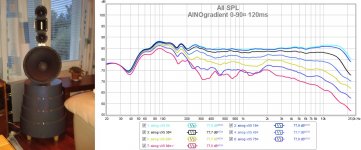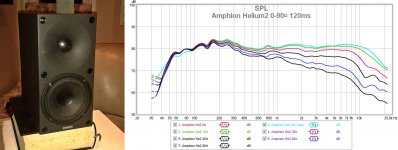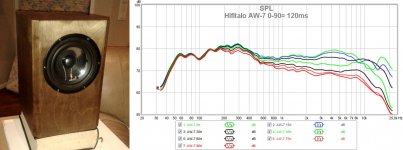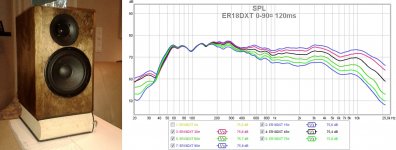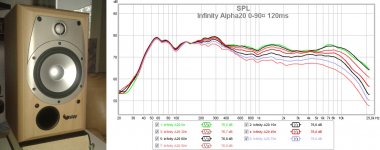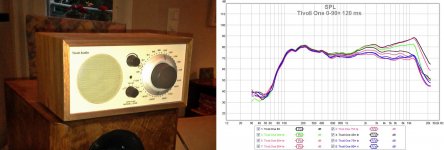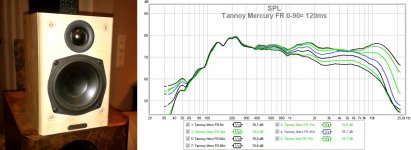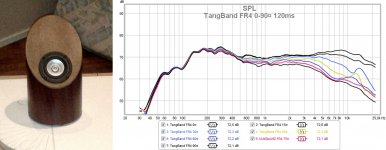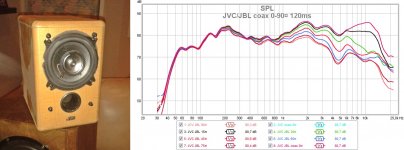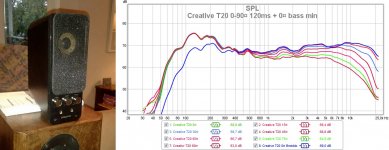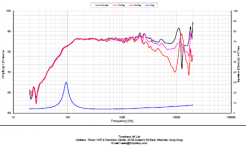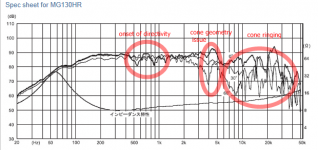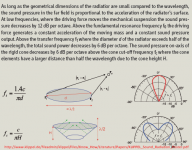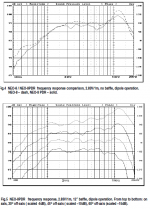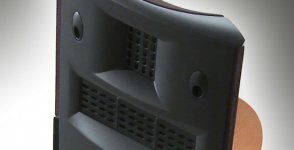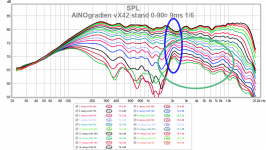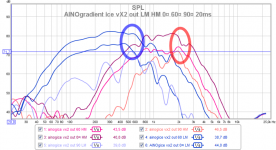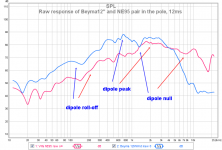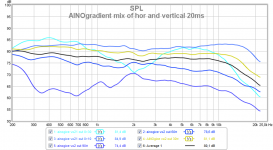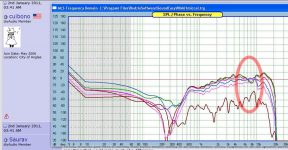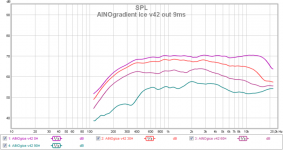Horizontal directivity of AINOgradient vs. 4 2-way monitor speakers.
All measured wit the speaker on a 80cm stand in the middle of the room, mic at 80cm distance. Floor bounces between 100 and 300Hz. Room mode at 45Hz.
The responses are not comparable to (pseudo)anechoid measurements! Pay attention only to differencies between these speakers.
Amphion Helium2 (commercial, 5"+1" in waveguide)
ER18DXT (diy by MarkK modified, 6½"+1"DXT)
Hifitalo AW-7 (a diy kit, 6½"+1" coaxial)
Infinity Alpha 20 (commercial, 6½"+1")
All measured wit the speaker on a 80cm stand in the middle of the room, mic at 80cm distance. Floor bounces between 100 and 300Hz. Room mode at 45Hz.
The responses are not comparable to (pseudo)anechoid measurements! Pay attention only to differencies between these speakers.
Amphion Helium2 (commercial, 5"+1" in waveguide)
ER18DXT (diy by MarkK modified, 6½"+1"DXT)
Hifitalo AW-7 (a diy kit, 6½"+1" coaxial)
Infinity Alpha 20 (commercial, 6½"+1")
Attachments
For whom it may concern...
Directivity of 6 minimonitors/table radios
These little ones suffer from very high distortion below 200Hz when measured at 80dB/80cm. The best was Tannoy followed by Sangean, JVC/JBL and TangBand
Creative T20 (2-way desktop active speaker 3"+½")
JVC/JBL (diy minimonitor 4½"+2" coaxial)
Sangean WR-2 (table radio 4")
TangBand FR4 (diy monitor 4")
Tannoy Mercury FR (commercial mini monitor 4½"+1 3/4")
Tivoli Audio Modle One (table radio 3")
Directivity of 6 minimonitors/table radios
These little ones suffer from very high distortion below 200Hz when measured at 80dB/80cm. The best was Tannoy followed by Sangean, JVC/JBL and TangBand
Creative T20 (2-way desktop active speaker 3"+½")
JVC/JBL (diy minimonitor 4½"+2" coaxial)
Sangean WR-2 (table radio 4")
TangBand FR4 (diy monitor 4")
Tannoy Mercury FR (commercial mini monitor 4½"+1 3/4")
Tivoli Audio Modle One (table radio 3")
Attachments
Last edited:
All cone speakers have a heart-like directivity pattern, based on the angle of cone and diameter. My AINOs have 3" (75mm) cones as upper mids and thy show this problem at 2kHz, where "beaming" begins. This behaviour makes a bump in directivity. I wish that the Audax behaves better, it has a bullet-shaped dust cap (or phase plug) that sould help a little. The real solution is a planar driver.
The second pic is from here http://www.klippel.de/fileadmin/klip...ion_Poster.pdf
and the last is a from a speaker driver's datasheet, pay attention to response at 60¤ Cone geometry related problems start at 1/2 of diameter relative frequency. The 130mm wide cone at 600Hz. 75mm cone at 2kHz.
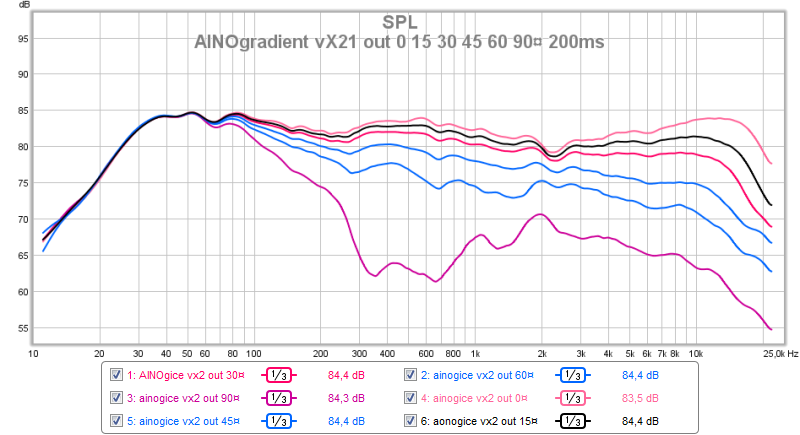
The planar I have in my mind is BG Neo8-PDR - a very popular driver an the price is around 100€. It's datasheet shows off-axis as dipole in a 12" wide baffle. This planar has a membrane width related directivity hickup at around 8kHz but the baffel masks it here (last pic) http://www.fuzion.co.uk/ftproot/Fuz...cyData/RadiaPro/Datasheets/Neo8_Datasheet.pdf
The second pic is from here http://www.klippel.de/fileadmin/klip...ion_Poster.pdf
and the last is a from a speaker driver's datasheet, pay attention to response at 60¤ Cone geometry related problems start at 1/2 of diameter relative frequency. The 130mm wide cone at 600Hz. 75mm cone at 2kHz.

The planar I have in my mind is BG Neo8-PDR - a very popular driver an the price is around 100€. It's datasheet shows off-axis as dipole in a 12" wide baffle. This planar has a membrane width related directivity hickup at around 8kHz but the baffel masks it here (last pic) http://www.fuzion.co.uk/ftproot/Fuz...cyData/RadiaPro/Datasheets/Neo8_Datasheet.pdf
Attachments
Last edited:
I thought you might end up with Neo8.
I am working on a similar set up. I have Faital 12", Neo8S, and Fountek 3.5H.
I will put 12" in a sealed box.
Neo8S will be on a wide open baffle.
But here is the catch: Neo8S will be placed horizontally to reduce CTC distance with the Fountek tweeter. Just like Martin Logan Mosaic speaker pictured. I will make my own PDR treatment: foam wedges on each side. This will hopefully help matching the dispersion of the Neo8S and Fountek horn tweeter. CO point will be somewhere btw 3000 and 5000hz (Mozaik CO is at 3000hz without foam wedges).
I am working on a similar set up. I have Faital 12", Neo8S, and Fountek 3.5H.
I will put 12" in a sealed box.
Neo8S will be on a wide open baffle.
But here is the catch: Neo8S will be placed horizontally to reduce CTC distance with the Fountek tweeter. Just like Martin Logan Mosaic speaker pictured. I will make my own PDR treatment: foam wedges on each side. This will hopefully help matching the dispersion of the Neo8S and Fountek horn tweeter. CO point will be somewhere btw 3000 and 5000hz (Mozaik CO is at 3000hz without foam wedges).
Attachments
I have given that horizontal position a thought too. The problem is that then the radiating area is roughly 170mm wide. This means that is starts beaming horizontally progressively from around 1000Hz up. Vertically positioned has width ~40mm and then it starts to beam at around 4,5kHz. It is hard to know how this works when going dipole. The curved baffle of Mosaic changes this a little too. The Neo8 datasheet doesn't show vertical directivity.
But I think that ML is intentionally using the membrane-diameter-determined directivity of the horizontal setting. It's baffle looks to be 20cm wide so acoustic dipolic directivity is practically disabled in it's range. They use a horn for the Neo3. Does anyone know? MartinLogan | Mosaic
It would be fantastic if you could show your measurements of Neo8S, can you do directivity both vertical and horizontal too?
But I think that ML is intentionally using the membrane-diameter-determined directivity of the horizontal setting. It's baffle looks to be 20cm wide so acoustic dipolic directivity is practically disabled in it's range. They use a horn for the Neo3. Does anyone know? MartinLogan | Mosaic
It would be fantastic if you could show your measurements of Neo8S, can you do directivity both vertical and horizontal too?
Last edited:
Please be carefull to not mix different effects. The individual cone directivity is well hidden behind the dipole directivity - at least up to the first dipole null. So what you see at 2 kHz is definitely NO cone beaming.All cone speakers have a heart-like directivity pattern, based on the angle of cone and diameter. My AINOs have 3" (75mm) cones as upper mids and thy show this problem at 2kHz, where "beaming" begins.
If you are referring to the loss of the 90° hole, I would relate that to the transition from dipole mid to omnipole tweeter.This behaviour makes a bump in directivity.
No. The real solution are drivers with a very small rim and no added baffle to speak of. 2-3 cm cone depth are nothing to worry about in a midrange driver.I wish that the Audax behaves better, it has a bullet-shaped dust cap (or phase plug) that sould help a little. The real solution is a planar driver.
Rudolf
"If you are referring to the loss of the 90° hole, I would relate that to the transition from dipole mid to omnipole tweeter"
No it's not. The peaking at around 2kHz is there also when I play NE95 without upper xo. The same with just one or twin drivers. When I set xo to 4500Hz I see that peak in directivity and also the on-axis response gets wimpy. These phenomenoms must be esplored more! I must wait for the Audaes to come. After measuring them I must consider going to planars.
No it's not. The peaking at around 2kHz is there also when I play NE95 without upper xo. The same with just one or twin drivers. When I set xo to 4500Hz I see that peak in directivity and also the on-axis response gets wimpy. These phenomenoms must be esplored more! I must wait for the Audaes to come. After measuring them I must consider going to planars.
Beyma12" has dipole peak at 800Hz, NE95 at 2kHz in my "baffle" - picture 1
Both show peaking at these F at 60¤ off-axis
NE95 peaking at 2kHz begins to appear at 45¤ and gets worse with larger angle. Beyma's peaking is better masked because it has LR2 xo instead of LR4 between NE95 an NeoCD
Both show peaking at these F at 60¤ off-axis
NE95 peaking at 2kHz begins to appear at 45¤ and gets worse with larger angle. Beyma's peaking is better masked because it has LR2 xo instead of LR4 between NE95 an NeoCD
Attachments
Last edited:
I don't have that kind of measurement capability.
But they have vertical directivity of Neo8S at Meniscus site.
http://meniscusaudio.com/images/NEO8S-spec sheet Rev1.pdf
and your guess seems to be spot on.
But they have vertical directivity of Neo8S at Meniscus site.
http://meniscusaudio.com/images/NEO8S-spec sheet Rev1.pdf
and your guess seems to be spot on.
And here is the measured effect of foam wedge treatment on the Raal 140-15D tweeter.
www.audioexcite.com RAAL 140-15D
Raal ribbon is 14cm tall, and with the foam wedges its vertical beaming is pushed to around 4000hz.
www.audioexcite.com RAAL 140-15D
Raal ribbon is 14cm tall, and with the foam wedges its vertical beaming is pushed to around 4000hz.
Examining the graphs above puzzles me. But in Rudolf's german pdf we can read/see that when we of far off-axis the dipole peaks shifts to lower frequencies. This is perhaps the explanation to off-axis peaking at 2kHz.
2" cone drivers can't go low and are not smooth up high - no use here
2" domes don't have any rear radiation - no use here
Neo8 and Neo3 are roughly 89mm wide - a possibility used open-back with "no baffle"
opposing 1" domes ala Rudolf - a possibility, with waveguides???
The requirements of upper mids and tweeter(s) for AINOs are:
- LR2 xo around 800Hz
- dipole peak as high as possible
- HM to T xo as smoothly as posoible both on- and off-axis
The responses of both Neo8 and Neo3 is shattered at high end. I really like the sound of NeoCD3,5H, it shines when crossed around 4-5kHz. John K's NaoO Note has highest xo around 4,5 kz and he says that he doesn't see back-firing tweeter needed.
ps. theoretically, Audax HM100 has 100mm frame and it should have its dipole peak even lower than NE95 with 95mm frame - a bad thing. But Audax has square frame which distributes dipole peak a little - we will see....
This thinking chain leads me strongly towars replacing NE95 pair with BG or to replace NeoCD with opposing domes... keep bubbling!
-
2" cone drivers can't go low and are not smooth up high - no use here
2" domes don't have any rear radiation - no use here
Neo8 and Neo3 are roughly 89mm wide - a possibility used open-back with "no baffle"
opposing 1" domes ala Rudolf - a possibility, with waveguides???
The requirements of upper mids and tweeter(s) for AINOs are:
- LR2 xo around 800Hz
- dipole peak as high as possible
- HM to T xo as smoothly as posoible both on- and off-axis
The responses of both Neo8 and Neo3 is shattered at high end. I really like the sound of NeoCD3,5H, it shines when crossed around 4-5kHz. John K's NaoO Note has highest xo around 4,5 kz and he says that he doesn't see back-firing tweeter needed.
ps. theoretically, Audax HM100 has 100mm frame and it should have its dipole peak even lower than NE95 with 95mm frame - a bad thing. But Audax has square frame which distributes dipole peak a little - we will see....
This thinking chain leads me strongly towars replacing NE95 pair with BG or to replace NeoCD with opposing domes... keep bubbling!
-
Last edited:
Here once again:
http://meniscusaudio.com/images/NEO8...eet Rev1.pdf
www.audioexcite.com RAAL 140-15D
http://meniscusaudio.com/images/NEO8...eet Rev1.pdf
www.audioexcite.com RAAL 140-15D
zmyrna, I am familiar with those links yes.
Here is a link to Rudolf's dipole tweeter tests http://www.diyaudio.com/forums/multi-way/161299-directivity-dipole-tweeters.html
I have read these many times...
Here is a link to Rudolf's dipole tweeter tests http://www.diyaudio.com/forums/multi-way/161299-directivity-dipole-tweeters.html
I have read these many times...
One possibility for me is to use LR2 for HM to T xo. But it means that I must use only one HM and that means 3dB more distortion...
In early stages of protoing I had this LR2 3500Hz and it measured very well. Then concern of mtm lobing and tweeter distortion made me go to LR4, first at 3500 then gradually to 2300Hz. LR48 doesn't change things.
The advantage of mtm symmetric vertical lobing is here - the horizontal peaking is compensated by vertical valley! The end result is seen in my room responses that are very smooth around 2kHz. It means that this 2kHz "problem" is not really a problem! Only those with a turntable for horizontal measurements will "see" it I believe that this compensation is what makes mtm speakers sound so good regardless of critisism to lobing etc., the other reason is reduced distortion.
I believe that this compensation is what makes mtm speakers sound so good regardless of critisism to lobing etc., the other reason is reduced distortion.
In early stages of protoing I had this LR2 3500Hz and it measured very well. Then concern of mtm lobing and tweeter distortion made me go to LR4, first at 3500 then gradually to 2300Hz. LR48 doesn't change things.
The advantage of mtm symmetric vertical lobing is here - the horizontal peaking is compensated by vertical valley! The end result is seen in my room responses that are very smooth around 2kHz. It means that this 2kHz "problem" is not really a problem! Only those with a turntable for horizontal measurements will "see" it
Attachments
Last edited:
I'm not sure that we are talking about the same things."If you are referring to the loss of the 90° hole, I would relate that to the transition from dipole mid to omnipole tweeter"
No it's not. The peaking at around 2kHz is there also when I play NE95 without upper xo. The same with just one or twin drivers. When I set xo to 4500Hz I see that peak in directivity and also the on-axis response gets wimpy. These phenomenoms must be esplored more!
Just for the record: The effective cone diameter of the NE95 is 6 cm, the basket diameter + basket rim depth (has to be taken twice) is 10,5 cm. To that you have to add the wooden baffle depth. All peaks and valleys in your NE95 measurements relate to the baffle dimensions, none to the cone dimensions. That's why I say that the Klippel chart tells nothing about the problems you have (or believe to have
Your left measurement in post #288 is a stunning example of "dipole vs monopole" directivity. Below 2 kHz we see the dipole directivity, where SPL diminishes progressively with angle. Above 2 kHz we see monopole directivity where SPL diminishes linearily. I'm thinking about adding your diagram to my website/PDF, because it is so instructive (Will ask for permission separately
I have seen quite a few dipole measurements where the 60° (or 90°) SPL is raised somewhat at the first dipole notch. It happens to cone drivers as well as to the Neo3 PDR. It even happened with my back-to-back dome tweeters. So don't hope this phenomenon will disappear with some other driver. I have no cue why it happens in some configurations and not always.
Rudolf
You are right Rudolf, my understanding is vague and I don't always get what others say. This is a learning process!
I have monopole tweeter, it was a decision done for many reasons - one was your conlusions about difficulties with dipole tweeters and John K's opinion that is is not needed with higher xo. Then I didn't know about difficulties of the mid driver to go dipolic above 2kHz.
I went back to my v4 that used LR2 (nearly) for M/T xo. It has the bst directivity of all, because of wide overlapping from dipolic to monopole radiation. I think that I'll give it a listen again!
I have monopole tweeter, it was a decision done for many reasons - one was your conlusions about difficulties with dipole tweeters and John K's opinion that is is not needed with higher xo. Then I didn't know about difficulties of the mid driver to go dipolic above 2kHz.
I went back to my v4 that used LR2 (nearly) for M/T xo. It has the bst directivity of all, because of wide overlapping from dipolic to monopole radiation. I think that I'll give it a listen again!
Attachments
Last edited:
I have given that horizontal position a thought too. The problem is that then the radiating area is roughly 170mm wide. This means that is starts beaming horizontally progressively from around 1000Hz up. Vertically positioned has width ~40mm and then it starts to beam at around 4,5kHz. It is hard to know how this works when going dipole. The curved baffle of Mosaic changes this a little too. The Neo8 datasheet doesn't show vertical directivity.
But I think that ML is intentionally using the membrane-diameter-determined directivity of the horizontal setting. It's baffle looks to be 20cm wide so acoustic dipolic directivity is practically disabled in it's range. They use a horn for the Neo3. Does anyone know? MartinLogan | Mosaic
It would be fantastic if you could show your measurements of Neo8S, can you do directivity both vertical and horizontal too?
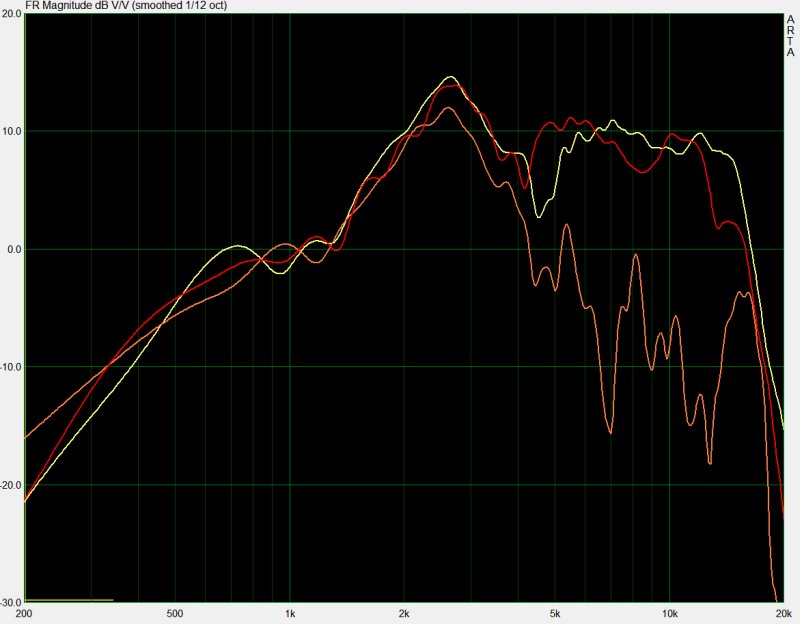
Here's my measurement of the NEO8 PDR on axis, 45 degrees off axis horizontally, and 45 degrees off axis vertically.
Basically it's horizontal directivity is really good, due to the flat diaphragm and the narrow width. Vertically it starts to beam like crazy.
If you flipped it on it's side, you'd get wide *vertical* directivity, which *could* lead to a nasty floor bounce. But running it dipole will help to offset that. Running it on it's side will definitely make aiming it trickier. At the same time, it may increase the ratio of direct to reflected energy.
I have some more measurements of this, including the NEO8 in a Paraline, over on my '28 days later' thread.
Also, this is an oddball of a NEO8; it's a NEO8 that Danny Ritchie at GR-Research has. It's a custom unit that is made exclusively for him, IIRC. (Not even sure if this variant is listed on his web site.)
Google "Roger Russel" or "IDS25" and check out his vertical line array speakers. Many people are building clones of these (rather than paying the $19K). If your room has a conventional 8-9 ft. flat ceiling, it's arguable that these will work much better with the effects of room acoustics. I've developed an active EQ circuit for the IDS25 clones that I can share.
- Home
- Loudspeakers
- Multi-Way
- Aino gradient - a collaborative speaker project
